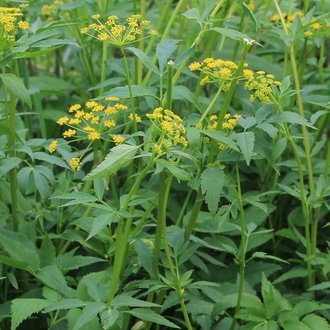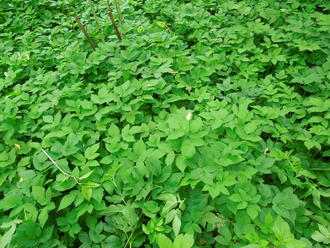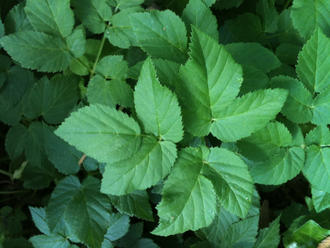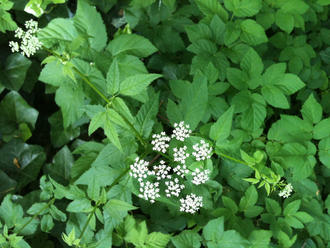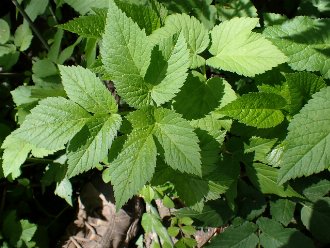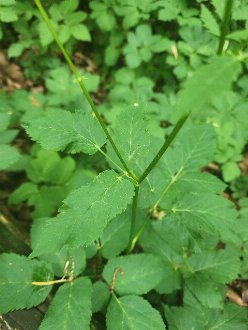Bishop's Goutweed (Aegopodium podagraria L.)
Also known as bishop's weed, goutweed.
↑Summary
An herbaceous perennial, native to Europe, which spreads aggressively, forming large colonies, by underground rhizomes. Escaped from cultivation at various locations across North America, mostly in the northeast, where it is considered invasive.
↑Range - Expand
| Legend | Color |
| Introduced | |
| Introduced or Not Present | |
| Garden Persistent |
This tentative map is based on our own research. It may have limited data on Canada and/or Mexico, and there is some subjectivity in our assignment of plants as introduced vs. expanded. Read more in this blog post.
Although this plant occurs somewhere in each of these regions, it may only occur in a small part of some or all of them.
The Canada portion of this map is derived from iNaturalist records; it is marked Garden Persistent in regions where there were reports showing it thriving in gardens, but we found no evidence of its presence in the wild.
↑Description & Identification
A patch-forming herbaceous plant. Basal leaves doubly-compound leaves usually divided into three sets of three, sometimes with some of the leaflets fused. Leaflets serrate or doubly-serrate. Upper leaves on flowering stalks becoming trifoliate to lobed to simple.
Flowers white.
↑Similar Plants
↑Habitat
Prefers partly-shaded, average to moist habitats, and loamy soils with high nitrogen content, possibly including some clay or sand. Tolerates heavy shade, but cannot reproduce by seed under such conditions. More tolerant of erosion and drought than many plants that prefer similarly moist, shaded conditions. Tolerates temporary flooding.
In North America, moist deciduous woodlands adjacent to suburbs or grown up on old farmsteads or abandoned property where this plant had been planted. Widespread near human development, especially suburbs, but uncommon in more remote areas.
↑Life Cycle
This plant spreads vegetatively by underground rhizomes, forming large colonies that often shut out most other plants. Blooms late spring to mid-summer, with seed maturing in the autumn. Seeds mostly fall close to the parent plants, but germination is typically negligible under the partly-shaded conditions in which this plant typically grows.
Seeds require high-light conditions to germinate and typically only germinate in response to disturbance that exposes the area to more light. In North America, reproduction is primarily vegetative.
Can spread aggressively by vegetative reproduction both in gardens and wild areas.
↑Control
This species is regarded as devilishly difficult to remove once established. However, in North America it rarely reproduces by seed, so it can be effective to work from the outside of a patch inward, and take special care to watch the edges of established patches and prevent its vegetative spread into new areas.
Small, isolated plants can be dug by hand, but care must be taken to remove as much of the root as possile. Plants are able to resprout from small pieces of underground root, and attempts to control this plant by hand-digging usually require repeated returning to remove resprouts. Take care not to spread this plant to new areas through its root fragments.
Large monocultures of this plant can be killed by covering them with black sheeting that blocks out light, for an entire growing season, but this will kill most other plants in the area as well, and can cause problems with erosion in the riparian habitats where this species often occurs. Regular mowing can also kill large patches.
Contact herbicide is ineffective at killing this plant, but systemic herbicides that also kill the root system can be effective. However, systemic herbicide can also kill competing plants, so it is best used only on large monocultures and not when this plant is growing together with other plants.
Although this species is tolerant of shading from a canopy of trees, it can sometimes be out-competed by herbaceous vegetation from species that grow taller than it.
↑Uses
Widely planted as a groundcover for shady areas, where it is valued for its ability to thrive in a partly-shaded garden setting, and its ability to quickly cover a large area and shut out unwanted plants. Its usage has decreased due to its invasive nature.
A cultivar exists with variegated white and green leaves. However, variegated plants frequently revert back to the all-green form, which grows more vigorously and usually displaces the variegated plants.
Young leaves are edible, and were historically eaten as a food, although are rarely eaten nowadays. The common name "goutweed" refers to the fact that this plant was eaten as a treatment for gout.
↑Related Plants
This is the only Aegopodium species found in North America; the genus is native only to Europe and western Asia, where it has about seven species.
There are two others plants of the Careae tribe of the Apiaceae family in North America, but both are introduced: Carum carvi (Caraway), and Falcaria vulgaris (Sickleweed).
The broader Apioideae subfamily contains yet more species, including the introduced Conium maculatum (Poison hemlock), and the genus Conioselinum, with several native species, including the misleadingly-named Chinese hemlock-parsley (Conioselinum chinense), which is native to North America.
↑Links & External Resources
• Bishop's Goutweed | Fire Effects Information System (FEIS) (About This Site)
• Aegopodium podagraria (Goutweed) | Illinois Wildflowers (About This Site)
• Aegopodium podagraria (Bishop's Goutweed) | USDA PLANTS Database (About This Site)
• Aegopodium podagraria | Go Botany (About This Site)
• Aegopodium podagraria | Biota of North America Project (BONAP) (About This Site)
• Aegopodium podagraria | NatureServe Explorer (About This Site)
• Aegopodium podagraria | Missouri Plants (About This Site)
• Bishop's Goutweed | Maryland Biodiversity Project (About This Site)
• Aegopodium podagraria (Goutweed) | Minnesota Wildflowers (About This Site)
• Aegopodium podagraria L. (Bishop's Goutweed) | Digital Atlas of the Virginia Flora (About This Site)





